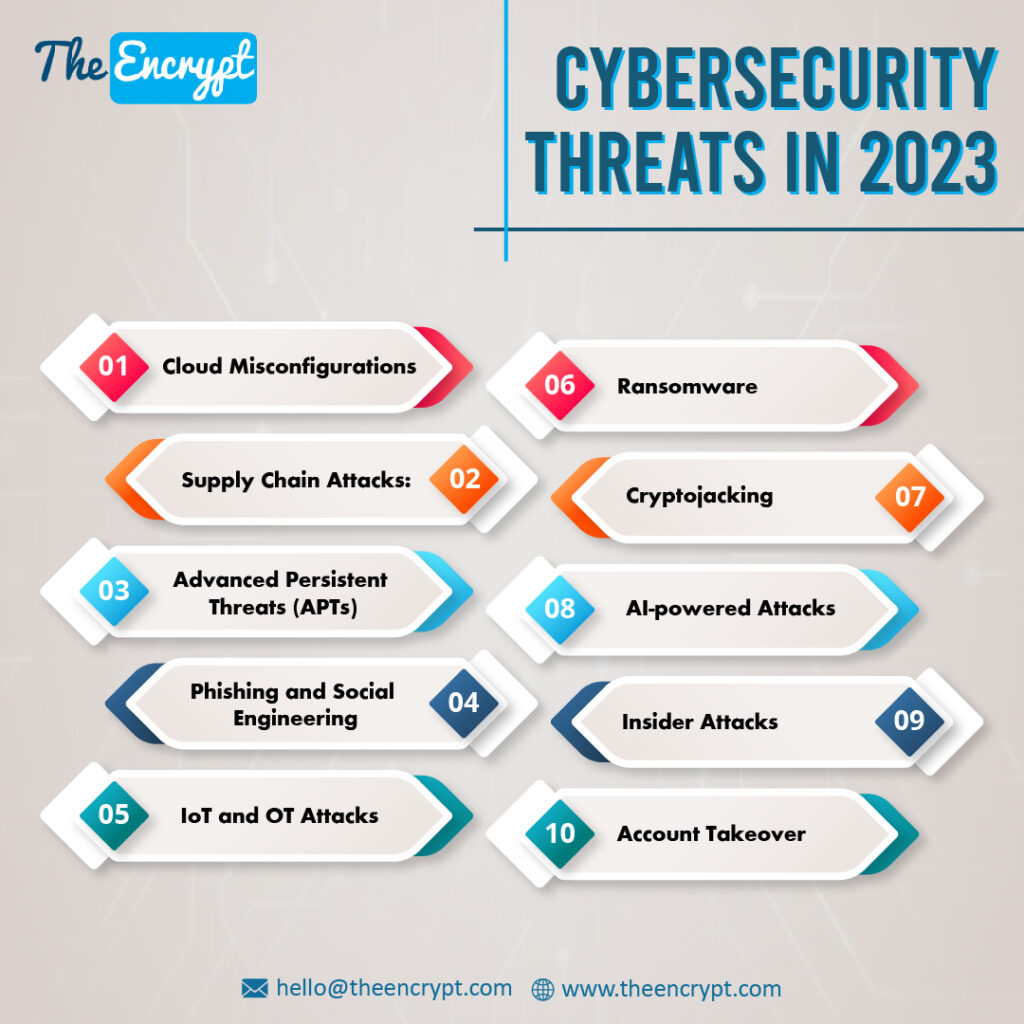
Cybersecurity threats are always on the rise. Cybercriminals are moving way ahead of cybersecurity professionals, honing their skills to break through any cybersecurity walls. The recent data from many surveys show the rising threat of cyber-attacks in almost every industry.
Considering the 2.8 billion worldwide malware attacks and 236.1 million ransomware attacks by mid-2022, 2023 is in danger. Moreover, phishing attacks also crossed the six billion mark in 2022.
Hence, it is high time for every sector of the industry associated with cyber works to implement challenging cybersecurity features. But the only way to stay ahead of cybercriminals is to get into their shoe. So, here we have listed several future cybersecurity threats which can create havoc in 2023 so that you can stay protected from all sides.
10 different types of cybersecurity threats
If you are wondering what the biggest cybersecurity threats are, find the list here.

1. Cloud Misconfigurations
Cloud is the new normal. Almost every organization globally is adopting the cloud to store huge amounts of data. It helps every part of the organization to access the data remotely at any time.
But the cloud can also be a big trap for organizations. It is at a huge risk of cyberattacks, considering the valuable data it stores. Cybercriminals can use the data to turn many tables and affect every individual associated with it.
Despite the advanced security system adopted by the company to protect their data over the cloud, a minor mistake or carelessness from a single user can give a free hand to cybercriminals. Hence, it becomes necessary for organizations moving to the cloud to tighten their security features and train their employees on the safe accessibility of the data.
2. Supply chain attacks
A supply chain is key to the proper functioning of any industry. It involves all the steps to be carried out to supply the products to consumers. Moreover, it includes all the channels leading to a company’s suppliers and vendors.
However, even the supply chain has threats to data security. It is because supply chain management includes the implementation of software these days. So, the best production companies can make their vendors and suppliers aware of the end-to-end security of the supply chain.
3. Advanced Persistent Threats (APTs)
Business email scams are the best examples of cybersecurity threats or advanced persistent threats that have continued for ages. They are expected to keep rising and looting people of their privacy and money in 2023. Business email scams involve legitimate-looking emails with trustworthy details and senders.
They mainly trap recipients into the immediate transfer of funds with fake promises of eventually benefitting them. Cybercriminals involved in Business email scams also get away with manipulating the bank transfer details of the employees in an organization.
Hence, these lead to unexpected and heavy losses in sensitive information and money. The best way to prevent such scams is to not verify the source of the business emails well before reacting to them.
4. Phishing and Social Engineering
Phishing, a part of social engineering, is one of the most common cyber security threats you can encounter in the upcoming years. It is because cybercriminals find it the easiest way to lure people into cyberattacks.
They use fraudulent but genuine-looking emails in the name of reputed organizations and coax out sensitive information from the victims. Phishing and Social Engineering are mainly associated with banks; thus, cybercriminals loot handsome amounts.
So, to not fall prey to social engineering tactics, it is necessary to not disclose private details concerning bank accounts and others to any emails. Verifying the sender’s whereabouts is an essential step toward cybersecurity awareness.
5. IoT and OT attacks
With machine learning and artificial intelligence making their way into a smart world, smart devices are the trend. Whether we talk about smart cars or mere lightbulbs, they are equipped with advanced features to instill convenience in daily life.
But, the rising trend of smart devices also makes them a potential prey to cybersecurity attacks. The remote-control access to these smart devices via Bluetooth and Wi-Fi makes them vulnerable to hacks and cybercrimes.
The more people near smart devices, the more prone it becomes to breaches and cyberattacks. Hence, smart devices need special attention with cybersecurity by adding more protective features.
6. Ransomware
Ransomware, as the name suggests, is malware involving ransoms. It hits the valuable data of many organizations, blocking their access to the same and demanding ransoms in exchange for the retainment of accessibility.
However, it never ensures the ransomware perpetrators will not make their way back to the company’s data even after satisfaction of the demand. Hence, ransomware is a cybersecurity threat, ailing many organizations and keeping them at the knife’s edge regarding disclosing their valuable data.
According to statistics, 2022 saw a 33% increase in ransomware attacks compared to 2021. So, it is only expected to touch heights in 2023, providing a tough task for cybersecurity.
7. Cryptojacking
Cryptocurrency is the voice of the era. You can hear it in almost every sector of the industry. Various organizations are spreading awareness about cryptocurrency and its benefits in the present world.
But such awareness can also get you in trouble. It can make you a part of online scams where cybercriminals try to befriend people by initiating a conversation about crypto. They lure you into investing in crypto and initially provide you with good profits.
However, it continues until you invest a big sum, which never returns to you. It is how you can fall prey to crypto-jacking, which is expected to grow in the upcoming years.
8. AI-powered attacks
AI-driven chatbots are living examples of artificial intelligence showering its blessing on technology. The latest and most advanced version of AI-driven chatbots is ChatGPT, a whole different world.
But the versatility of chatbots does not prevent them from being a source of cybersecurity attacks. The way chatbots generate responses to any question put before them, phishing attacks and social engineering get easier and easier.
Cybercriminals can use chatbots, especially chatGPT, to create malicious codes, phishing emails, and whatnot. Over that, sending malicious emails to millions of recipients on their valid email ids is no big deal for chatbots. Hence, chatbots have a high chance of providing helping hands to several cybersecurity threats in 2023.
9. Insider attacks
Organizations face a hard time dealing with cyberattacks from the outside. But, sometimes, the threat lies right under their noses. Insider attacks have become common in companies, putting their privacy at risk.
It is due to the irresponsible behavior of internal employees regarding security, making them deal lightly with important passwords and protective features. It provides an upper hand to data leaks, and the propriety information of companies becomes vulnerable.
So, the best way to protect against cybersecurity threats in terms of insider attacks, organizations can implement social engineering audits for the employees. It can help them keep track of workplace security policies.
10. Account takeover
Account takeover is another cybersecurity incident you can come across often. It is mainly associated with online accounts over social media and other platforms. Cybercriminals attempt to take ownership of online accounts by stealing passwords.
Hacking passwords and credentials no longer remains a big deal with the dark web. It provides cybercriminals with password access to online accounts through data breaches, social engineering, phishing attacks, etc.
Hence, you must use strong passwords to secure your account and prevent cyberattacks. Moreover, it is advisable to keep changing your passwords from time to time.
Conclusion
Cybersecurity is an essential part of technology. It contributes to the safety of organizations and individuals over the internet. Hence, there are more and more people making their way to making the cyber world secure. But, the cybercriminals, too, always continue learning. The rising trend in the past few years provides a doorway to cybersecurity threats in 2023. Hence, organizations can look out for these cybersecurity threats and keep all doors barred from the hawk eyes of cybercriminals.
